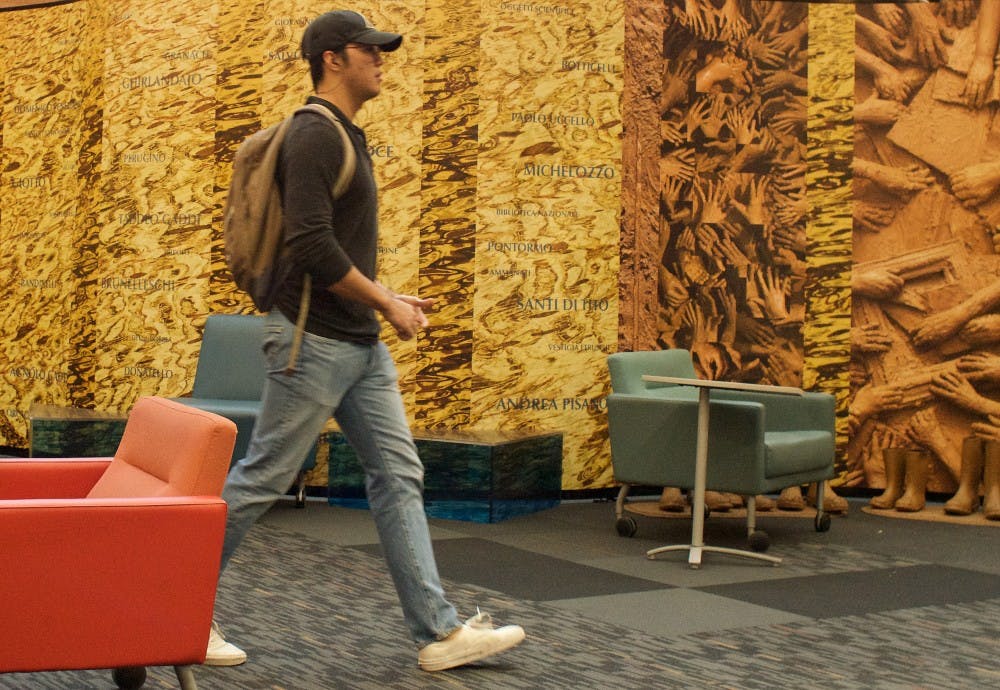Water: perhaps the greatest enemy of any book, museum or library. There are rules in nearly every institution where paper or art can be found that regulate its consumption because just one accidental spill can lead to catastrophic results. However, what happens when a massive flood leads not only to artistic destruction, but threatens an entire city?
Fifty years since the terrible flooding in Florence, Italy on Nov. 4, 1966, artist and professor, Ellen Murray’s art installation “Deluge” aims to remind students and faculty of the events that took place on that horrific day and the volunteer effort to save Florence.
There was large rainfall throughout Italy in Oct. 1966. By the time it had reached Nov. 3, Italy was dealing with record rainfall, with the equivalent to a quarter of a year's rain falling in one day. As a result, the Arno River could no longer hold the added water, causing a flood.
Murray, who has taught at ASU since 1986 specializing in painting and drawing, said that it had been nearly a century since Florence had a major flood.
“The last major flood in Florence before 1966 was 1844,” she said. “So people were not expecting anything like this. It really probably caught 90 percent of the population off guard.”
The flooding waters were coming at speeds of 40 mph throughout the city and taking everything with them, Murray said. Due to all of the mud that had accrued from the flooding, many people had to dig into the mud in order to save books, paintings and other works of art.
The volunteers who came to help in the aftermath of the flood were called Mud Angels or Angels of the Mud, and while initially being made up of local students, the relief effort grew to neighboring cities and other countries. They had to work day after day through the mud to salvage what they could of Florence’s art.
“[They came] when the realization was that not only was there great economic loss and the city was in shambles, but the art of Florence was really in danger as a result of the flood,” Murray said.
In her art piece, “Deluge,” the many hands that can be seen throughout the piece represent these Angels of the Mud, and the boots symbolize all of the different kinds of people who came to assist after the flood.
“The first part of the piece is a wave form of water rushing through the city,” Murray said. “The second part of the piece deals with digging out of the mud with shovels. Also it deals with the fact that individuals were literally digging into the mud to save books and to bring paintings out of the museums.”
Besides the installation, the exhibit also features several other pieces of work from Murray inspired by materials from the Arno river.
Along with painting and drawing, Murray also has an interest in interdisciplinary studies and recently became a sustainability scholar. According to the event page for the art installation, her interdisciplinary interests pose questions that relate to environmental, social, economic and human issues and how those relate to art, science and sustainability.
It was through her interest in these topics that she began her research into the flood.
“I was doing a lot of background research on the flood,” Murray said. “I ended up having a marvelous opportunity to propose an exhibit for Santa Croce in Florence. As a result of that, I was really inspired to deal with the two aspects of the flood.”
She began working on the project around the 40th anniversary of the flood in 2006 and it premiered at the Santa Croce Church and Museum in Florence. It was viewed by over 70,000 people.
It is now being shown in the Noble Science Library on ASU's Tempe Campus, a library that has faced its own flooding in its recent past.
Rene Tanner, associate librarian at the Noble Science Library, said that there have been two incidents since 2013 when the library faced flooding.
“The first flood I think was 3 years ago, and then it was only a year after that for the second flood,” Tanner said. “The first flood was the result of the sprinkler system coming on in the middle of the night … then the second flood was a pipe that had burst.”
In the first incident, no art or books were damaged, and in the second, there was damage to some bound journals, Tanner said.
“I really wanted to be part of this 50th anniversary having known the personal impact of flood waters,” Tanner said.
Several of Murray’s students were able to see the installation for themselves. Painting senior Juan Oliveros said that the part of the installation that resonated with him the most was the boots.
“There was so much story behind them," Oliveros said. "Ellen was talking about how they worked day and night, trying to save those books, pieces, anything basically that they could.”
Painting and geography junior April Chiarle said the part that stuck out to her was the watercolor work because she could feel what Murray felt.
“It was just really intense,” Chiarle said. “There were a lot of emotions coming off from it. Whether it was Ellen’s emotions through the photographs or people’s emotions who were being photographed.”
She also said that her hope for people when they see this piece is that they get an appreciation for the arts.
“I would hope they see how much other people care about the arts,” she said. “When the flood happened, so many people flocked to help, and it was just such a huge movement and a sense of community brought together for the art.”
“Deluge” can be found in Noble Science Library until Dec. 12.
Reach the reporter at balnero13@gmail.com or follow @BaldnerOwen on Twitter.
Like The State Press on Facebook and follow @statepress on Twitter.




